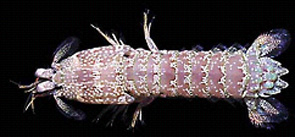| Fixation versus preservation
Joel W. Martin Natural History Museum Last updated: 12 December 2004 |
 |
Introduction
The words fixation and preservation are used casually and often incorrectly in the collection care literature. There is a distinct difference between a fixative and a preservative. In general, fixation is more desirable for histological or detailed morphological studies, but specimens should never be stored in any fixative for long (or even short) periods of time, and indeed, with many crustaceans, fixation may not be necessary at all (as opposed to preservation in ethanol or other preservative).
Fixatives
A fixative actually "fixes" a specimen by stabilizing (cross-linking) the proteins within its tissues such that long afterwards, the tissues will still retain a semblance of their appearance in life. Additionally, fixing usually raises the refractive index of the tissue making it more susceptible to staining. By definition, then, a fixative is a toxic chemical with a strongly adverse affect on tissue, in a sense chemically "freezing" the tissues permanently in place. The most common fixative for biological specimens historically has been formalin. When purchased commercially (where it is usually labeled ("formaldehyde solution"), this is a 37%-40% aqueous solution of the gas formaldehyde. To make "10% formalin" (the most commonly used fixative), the commercial solution must be diluted using 9 parts water to 1 part commercial formaldehyde solution. For marine taxa, to prevent distortion due to osmotic forces, the 9 parts water should be clean, filtered seawater. The resulting solution is acidic and therefore is detrimental for specimens containing CaCO3, which unfortunately is present in the skeletons of many taxa. To neutralize or "buffer" the acid content, small amounts of sodium hydroxide, sodium tetraborate, or the organic base hexamine are sometimes added. However, this buffering is apparently temporary, as buffered formalin will become acidic again some time after buffering; specimens should never be stored in formalin for extended periods of time.
Fixation should be limited to a period of a few hours to a few days -- long enough so that all tissues come in contact with the fixative but not so long that the specimen becomes brittle, which can happen if left in formalin for too long a period. A 24-hour period is probably ideal, in the absence of taxon specific guidelines. "Relaxing" the specimen by adding some kind of nacotizing agent (e.g. chloral hydrate, epsom salts, menthol, or other chemicals; see Knudsen, 1966: 510) to the water in which it is being held prior to killing and fixation or preservation is helpful for avoiding extreme contractions that can distort the anatomy and cause loss of appendages (autotomy). Following fixation, the specimen should be rinsed thoroughly in fresh or distilled water, after which it is usually transferred to 70% ethyl alcohol (ethanol) for long-term storage.
Formalin denatures DNA (or rather makes it unavailable by the binding of the surrounding histones) so that it is far more difficult, and in some cases impossible, to extract for molecular studies in the future. Actual damage to the DNA might be caused not so much by the formalin as by the associated low pH (even, in some cases, after buffering, as the acidity apparently increases over time in stored collections; see Bucklin and Allen, 2003). Although there are reports of success in extracting DNA from formalin-preserved specimens, some even from archival collections decades old (e.g. France and Kochler, 1996; Bucklin and Allen, 2003; Schander and Halanych, 2003), if sequencing or other gene-based work is desired it would be best to avoid fixation altogether.
Preservatives
A preservative, in contrast to a fixative, is a solution in which the specimen can be stored and maintained without further degradation. By far the most common preservative for marine animals is ethyl alcohol (ethanol), usually in a concentration of 70 to 75%. The primary role of the preservative is to provide an environment in which bacterial and other infestations and contaminations are unlikely, thus maintaining the specimens over long periods of time.
Because ethyl alcohol is the primary component of liquor, researchers can use, and often have used, commercially-purchased hard liquors (vodka, gin, tequila, etc.) in the appropriate strengths for temporary preservation of specimens. In our Caribbean study of shallow-water invertebrates (Zimmerman and Martin, 2004), we purchased and used cases of 150-proof (= 75% ethyl alcohol by volume) rum, which was less expensive by far than purchasing pure ethanol in the Caribbean and had the added benefit of creating a pleasing aura in our makeshift lab. Similar reports abound, and appear to be limited only by the taste (literally in some cases) of the investigator. There have been no studies on what effect, if any, other ingredients or additives in such drinks have on the long-term well being of the specimens (not to mention the researchers).
References
Bucklin, A., and L. D. Allen. 2003. MtDNA sequencing from zooplankton after long-term preservation in buffered formalin. Molecular Phylogenetics and Evolution30: 879-882.
France, S., and T. D. Kocher. 1996. DNA sequencing of formalin-fixed crustaceans from archival research collections. Molecular Marine Biology and Biotechnology 5: 304-313.
Knudsen, J. W. 1966. Biological Techniques: Collecting. Harper & Row, Publishers, New York.
Schander, C., and K. M. Halanych. 2003. DNA, PCR and formalinized animal tissue -- a short review and protocols. Organisms, Diversity & Evolution 3(3): 195-205.
Zimmerman, T. L. and J. W. Martin. 2004. Artificial reef matrix structures (ARMS): an inexpensive and effective method for collecting coral reef-associated invertebrates. Gulf and Caribbean Research 16: 59-64.
| Home | MethodsHome | For Anatomy | Fixation vs. preservation |
| Genetic Resources | Technique Table |